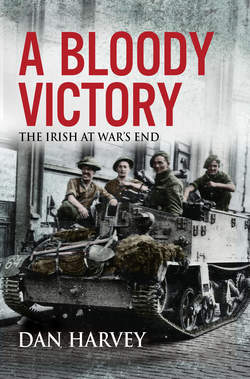Читать книгу A Bloody Victory - Dan Harvey - Страница 10
На сайте Литреса книга снята с продажи.
ОглавлениеAUTHOR’S NOTE
Victory in Europe was declared. The war was over. The Germans had finally capitulated. In early May 1945, three different German delegations signed three separate surrender documents: for the British on 4 May in Lüneburg Heath; for the Americans on 7 May in Rheims; and for the Russians on 9 May in Berlin. Hitler had ended his own life at his command post in the Führerbunker near the Reich Chancellery building in Berlin. Within days, the heavily defeated German army surrendered, and the fighting had finally finished. Militarily overcome, the Nazi regime capitulated only because it was overwhelmingly overpowered and overrun. Germany had been made to yield.
Despite Allied and Russian victories at the Battle of Britain, Stalingrad and D-Day, each a turning point in the war, the fervour of the vehemently fanatical fascist regime had remained intact and so needed to be vanquished. It would have been entirely logical and proper for Germany to cease military operations; the Allies on the newly created Second Front had successfully achieved a lodgement, broken out at Normandy, liberated Paris, and driven fast eastwards, and the Russians on the Eastern Front were pressing westwards. It was irrational to believe that Germany could now succeed, but for the Third Reich it was intolerable to believe that they must now concede. An assassination attempt on Hitler having failed – Operation Valkyrie, on 20 July 1944 – the conflict continued. Instead of ending the war and suing for peace, the levels of hostility and horror increased. The resistance to the Allied advances across Europe intensified. There was no backward step; the Germans fought where they stood. Every city, town, river crossing and area of high ground on the Allied forces’ advance was desperately defended. The Germans, severely stricken, took heavy losses in personnel and territory, yet remained dangerously determined; every inch of the fatherland was bitterly contested.
With the Allies were the Irish – many Irish; thousands of Irish. At least 120,000 Irish in British uniform: 70,000 from the ‘neutral’ south, and 50,000 from the ‘loyal’ north. The story of the Second World War is enormous, and because the Irish populated its many events, they have a rightful place among its many chapters, something not readily acknowledged at home in Ireland, even today. This book, along with others in a series I have written on the Irish in the Second World War, attempts to excavate them from the corners of Irish history and place them back on the D-Day beaches, the bridge at Arnhem, the frozen landscapes at the Battle of the Bulge in the Ardennes, the banks of the Rhine River, into the unimaginable horrors of the Bergen-Belsen and Luckenwalde concentration camps, and at the Battle of Berlin itself. There was no one individual ‘Irish Narrative’, but there was a narrative of single individual Irish. Whichever way you look at it, the Irish were there. There was an Irish contribution, and it was a significant one. This book highlights the Irish involvement at the end of war, focusing on Irish participation from late 1944 until mid-1945. However, it does not presuppose knowledge on behalf of the reader, so included in the opening chapter of this book is a summarisation of the opening of the Second Front – the contribution of the Irish at D-Day and Arnhem. Both contributions were the subject of prior titles in the series; for those who have read these books, the summary here includes newly researched Irish involvement – that of native-born Irish and of the wider Irish diaspora – that have come to light since the prior books were published.
It is, I believe, important to be aware that the Irish were, in fact, there, and also to have an understanding of why. As ever, it was for a number of reasons: to seek adventure, for money, for family tradition. But it was also for altruistic reasons: many selflessly believed that Hitler had to be stopped, that he was a world problem, and that it was the best way to defend Ireland. Many of them agreed with the Irish State’s neutral stance, but for them it was not enough; they had to do more and so became involved in actually fighting in the war. So who were they, and what did they do? I am privileged in granting them worthy mention.
